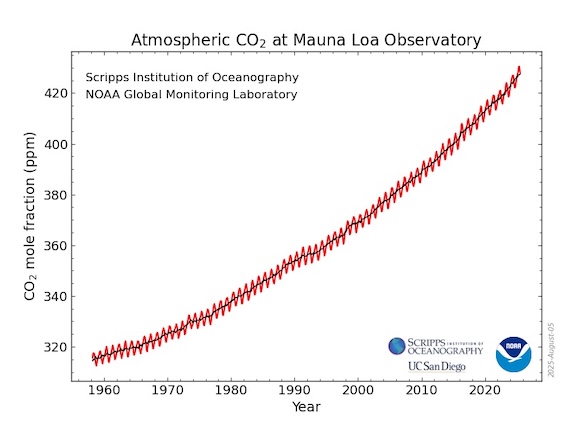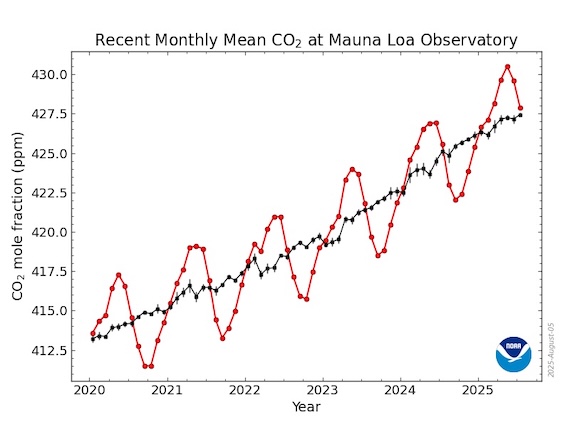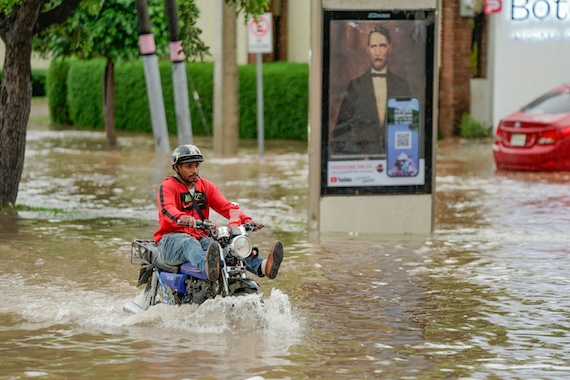Ann Arbor (Informed Comment) – The American Meteorological Society has issued its annual climate report, this one summarizing changes in 2024 now that all the data is in. It paints an alarming picture, especially at a moment when Big Oil has taken over the US government via its Republican puppets and is spiking all our efforts to reduce carbon dioxide emissions and to move to green energy. Carbon dioxide is a dangerous greenhouse gas, which keeps the sun’s heat from radiating back out into space, and acts like someone set off atomic bombs in the atmosphere. People think nothing of burning gasoline in their cars, or coal and fossil gas for heating or electricity, but would be freaked out if someone detonated atomic bombs in the sky over their homes every day. But it comes to the same thing.
AMS says that the global average of carbon dioxide in the atmosphere rose to about 422.8 parts per million in 2024, a 52% increase over the level of about 278 ppm that had prevailed in the 18th and previous centuries before the Industrial Revolution.
The last time the atmosphere held this much CO2 was the Pliocene era from 5 to 2 million years ago. Half of Florida was under water and sea level was many feet higher. The seas may not rise as much in our era because we’re coming off a cold period. But Louisiana, Washington, D.C., New York City and the whole countries of Egypt and Bangladesh would suffer tremendously even with just a 15 to 20 foot sea level rise.
Graphs via NOAA, for as long as it lasts:


—–
Never miss an issue of Informed Comment: Click here to subscribe to our email newsletter! Social media will pretend let you subscribe but then use algorithms to suppress the postings and show you their ads instead. And please, if you see an essay you like, paste it into an email and share with friends.
—–
Really bad news: from 2023 to 2024, CO2 concentrations in the atmosphere rose by a whopping 3.4 parts per million. That equals the growth from 2015 to 2016, the highest rate recorded since the 1960s.
Folks, we’re supposed to cut additional carbon dioxide emissions to zero, not increase them by record amounts.
The average surface temperature of the earth for last year was the hottest ever on record going back to 1850, which probably means the hottest since about 122,000 years ago before recent episodes of ice age.
That’s hot.
Some of the extra heat was owing to the El Niño in the first half of the year, but El Niños are cyclical, occurring every few years because of shifting wind and current patterns in the Pacific, and you don’t get ever-increasing heat records only because of a cyclical phenomenon. The secular increase is because of the significant augments in CO2. Many new record temperatures were set. The AMS says these temperature highs were reported by those countries that are keeping records. The United States under Trump may fall out of that category, though many individual American states will likely go on keeping their own records.
Entire glaciers definitively died off, including all the ones in Venezuela and the Conejeres in Colombia. Those that survive were put on a diet by the heat; the authors say, “Glaciers lost a record amount of their mass in 2024; all 58 reference glaciers across the globe reported loss.” The earth is a big place and regional climate varies, so it is unusual that all 58 reference glaciers should shrink in concert. It only ever happened once before, in 2023. Things are getting worse.
The oceans used to be cool, but they are rapidly heating up, too. Last year’s average sea surface temperature was hotter than at any time since records began being kept 171 years ago. Heatwaves struck almost everywhere in the oceans, sparing only 9% of their surface.
Global heating and climate breakdown cause hurricanes to be more intense and to drop more water when they make landfall. While there were not more hurricanes than usual in the past two years, the ones we had were doozies. Yagi in the Pacific rose to the level of super typhoon and devastated Vietnam and China, killing 800 people. Hurricane Helene blew down trees and houses from Florida up into the Appalachians and flooded out the latter, killing 200 people. Not since Hurricane Katrina devastated New Orleans in 2005 had a storm taken that many American lives. Then Milton hit Florida again, only 12 days later.

Photo of Dominican Republic, 2024, by Aldward Castillo on Unsplash
More heat leads to more evaporation of water and more moisture in the atmosphere, which leads to more rain and more flooding. You’d think the least likely place for the international airport to be shut down by heavy rainfall and flooding would be Dubai, not far from the Arabian Empty Quarter desert. But that’s what happened last year.
A sudden downpour in Valencia in Spain killed over 200 people and did extensive damage, and got the mayor and even the central government in trouble. The prime minister and his cabinet were just cleared in late July of criminal negligence. Locals had charged that they didn’t send the necessary warnings from Madrid to Valencia in time to save all those lives, but the high court could find no evidence for any negligence. Ironically, the socialist government of Pedro Sanchez has been the best on green energy in Spain’s modern history. But the episode suggests to me that as climate disasters get worse and more frequent, politicians like those in the US Republican Party who are seen by the public as responsible will increasingly face risks from angry constituents. Of course, Spain’s public may be less misinformed than those of the backward US, which suffers from media monopolies like that of Rupert Murdoch that deliberately falsify the news about issues like climate change. Abraham Lincoln, though, pointed out that you can’t fool all the people all the time.


 © 2025 All Rights Reserved
© 2025 All Rights Reserved